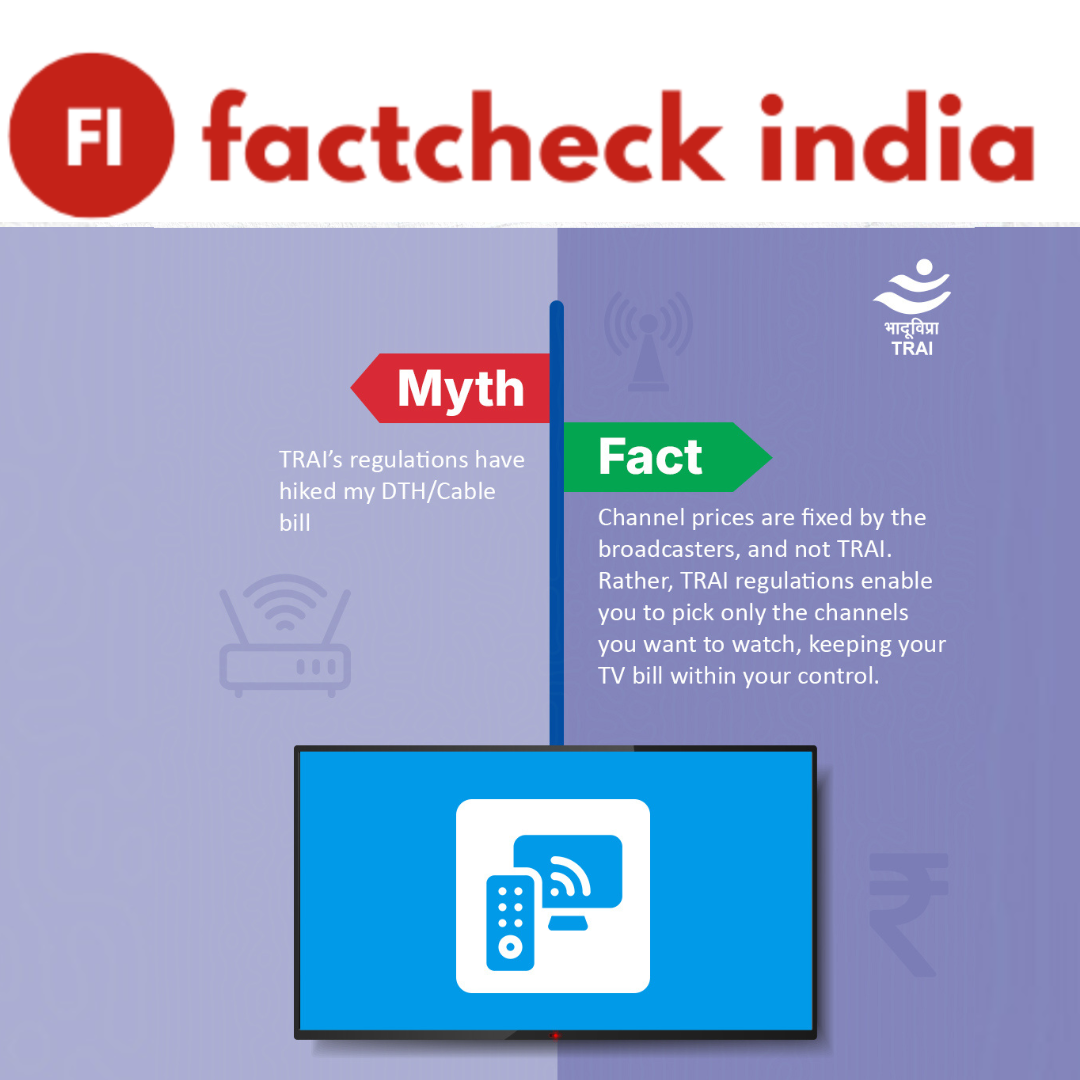Claim: TRAI claimed on social media that it is not responsible for the increase in monthly television bills, stating that “channel prices are fixed by broadcasters, not TRAI.”
Verdict: Misleading. While technically correct, TRAI’s statement omits critical context. Through multiple amendments to its New Tariff Order (NTO) over the years, TRAI has directly influenced TV pricing structures, limiting true consumer choice and causing higher bills.
What Did TRAI Say?
In a social media post meant to address rising consumer complaints about inflated TV bills, the Telecom Regulatory Authority of India (TRAI) issued a so-called fact-check, stating:
“Channel prices are fixed by broadcasters, not TRAI.
TRAI only empowers consumers to choose what they want to watch.”
The post positions TRAI as a neutral facilitator of consumer choice, rather than a player in TV pricing.
Reality: What TRAI Didn’t Tell You
TRAI’s message is only a half-truth. While broadcasters technically set the MRP (Maximum Retail Price) for channels, TRAI’s NTO regulations dictate how those prices can be packaged, bundled, and discounted.
Let’s break this down:
NTO Impact: A History of Price Intervention
- NTO 1.0 (2019): Set MRP cap at ₹19 for channels to be included in bouquets.
- NTO 2.0 (2020): Reduced the bouquet eligibility cap to ₹12—excluding many premium channels from packs.
- Later Amendment: Returned the cap to ₹19 due to pushback from stakeholders and litigation in courts.
Result: These constant changes led to unstable pricing, reduced bundling, and increased monthly costs for consumers.
Claim vs. Ground Reality
Claim 1: “Channel prices are fixed by broadcasters.”
Technically true but it is contextually misleading.
Why? TRAI’s bouquet pricing rules and discount limits severely restrict how broadcasters can price and package channels.
Claim 2: “TRAI empowers consumers with channel choice.”
Intended goal but failed execution.
Why? TRAI’s app for à la carte selection is poorly designed and barely promoted. Most viewers are still auto-migrated to default “best fit” plans by DPOs (cable/DTH operators), with limited transparency or ease of control.
Why Have TV Bills Increased?
Here’s how TRAI’s regulations indirectly pushed TV costs up:
- Base Fee: ₹130/month + taxes for 100 free-to-air (FTA) channels (often not including popular ones).
- Add-On Packs: A basic bouquet of 95 channels can cost ₹184 or more.
- Network Capacity Fees: Additional ₹25–₹100 for extra channels or packs.
- Premium Content/HD: Charged separately, often doubling the cost.
Prices are as follows:
Total Monthly Bill (SD viewing): ₹400–₹450
For HD: Closer to ₹700+
All of this due to a regulatory environment that promotes complexity over clarity.
Stakeholder Frustration & Call for Forbearance
Even industry leaders have called for a “light-touch regulation” model:
- Anil Malhotra (ex-Siti Network, now ZEEL) noted that TRAI is “the most frustrated stakeholder” and should limit itself to must-carry/provide mandates—not price control.
- The distinction between commercial and household subscribers is also overlooked in TRAI’s model, making the current system unfair and outdated.
Conclusion
The claim that TRAI does not influence TV pricing is misleading. TRAI’s ‘Fact-Check’ Is a Half-Truth That Ignores the Real Story. While TRAI doesn’t print your bill, it wrote the rulebook that determines how pricing works.
Its regulations have:
- Confused consumers,
- Complicated channel selection,
- And increased monthly costs.
So, is TRAI’s “fact-check” truly a myth-buster?
It’s a half-truth wrapped in regulatory jargon. The Telecom Regulatory Authority of India may claim innocence in the rising cost of TV bills, but the evidence tells a different story. Over the past six years, TRAI’s evolving and often contradictory tariff policies and especially the introduction and revision of the New Tariff Orders (NTOs). They have directly reshaped the pricing architecture of Indian television.
TRAI’s claim that it doesn’t control TV prices is technically correct but contextually deceptive. Through years of tariff regulations and constant policy shifts, TRAI has shaped the very system that made TV viewing more expensive and confusing. By limiting how channels are bundled, capping discounts, and failing to deliver real consumer choice, TRAI didn’t just influence pricing. It engineered it. Its so-called “fact-check” isn’t a clarification; it’s a carefully crafted escape from accountability.
Final Thought: Is This Transparency or Regulatory Spin?
TRAI’s post may technically “debunk” the narrow claim that it sets channel prices, but its historical and ongoing policy decisions have directly shaped how much Indian consumers pay and how little control they actually have.

